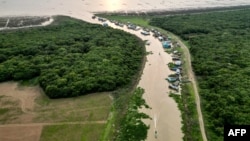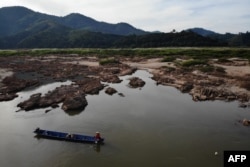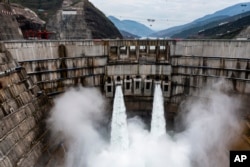Cambodia’s enormous Tonle Sap lake and its surrounding communities are struggling against a mighty combination of threats these days: climate change, upstream dams and the ravages of illegal fishing.
The three-year stretch from 2019-2021 was the driest on record. The Tonle Sap’s vital flood pulse — in which the lake expands to as much as five times its dry-season width, thanks in part to the reversed flow of the Tonle Sap river — appeared to be dying, along with much of the lake’s bountiful fish stocks.
The past two years have seen more rainfall, a nearly normal wet-season lake band and even reversed Tonle Sap flow — all welcome news to environmentalists and fishing communities. But any temporary relief is consumed by the long-term effects of a lake in crisis, experts and officials told VOA Khmer over the past two months.
“The new normal is uncertainty,” said Brian Eyler, who directs the Stimson Center’s programs on Southeast Asia and energy, water and sustainability.
“I think that's the new normal. That the predictability of a traditional expansion happening nearly every wet season, or every monsoon season, cannot be relied upon. And given the impacts of dams and the variability of weather, it’s very likely each year is going to be unique in terms of the ability of the Tonle Sap to expand, how much it expands, where the expansion comes from and the quality of the contents coming into the lake.”
Over the past two years, the Tonle Sap lake has reached nearly normal total flow, according to Stimson’s Mekong Dam Monitor project. However, in 2022 much of that flow came later in the wet season due to heavy rainfall, meaning the lake missed out on early-season inflows that carry sediment, larva and nutrients crucial to annual fish stocks.
Last year saw monthly flows that nearly tracked historical averages, and with it a decent fishing season, according to the Stimson Center, which is based in Washington DC.
“So the fishery has been OK. I wouldn't say it's been ample or impressive, but you know, there's a relationship between the quality of the expansion and the fish catch, and so far you're still seeing that relationship play out,” Eyler said in a zoom interview in January.
“For now, the ecosystem of the Mekong seems to be that if the expansion can be closer to somewhat normal than the fishery will be, it's not like it was before, but it's still there. It hasn't completely died out.”
Fears of the ecosystem dying out have drawn international attention, given the Tonle Sap’s distinction as one of the world's most productive inland fisheries — and as the source of a majority of Cambodians’ annual protein consumption.
In 2020, National Geographic published a warning that “Cambodia’s biggest lake is running dry” and facing an “existential threat” that also endangered the flooded forests, which are crucial to aquatic life and absorb more carbon than normal forests.
Journalist Abby Seiff, in her 2022 book “Troubling the Water,” wrote about how the ongoing droughts and damming of the Mekong River was transforming the social fabric of Cambodia, woven over centuries with the Tonle Sap at its center.
“Without the pulse, there is no water for the rice paddies surrounding the Tonle Sap. The stagnation changes how fish migrate and nutrients move. What is left of the lake?,” Seiff asked in her book.
There are multiple culprits for the abnormally dry years and decimated fisheries, including unpredictable weather driven by global warming, and corruption and collusion that allow illegal fishing to thrive, as Seiff’s book details. And there are upstream dams, built in recent years to provide hydropower to China, Laos and Thailand.
The Mekong Dam Monitor is seeking to track where flow is coming from, where it is being stopped upstream, and how the decisions made by each of the countries are impacting the other nearby nations.
According to its data, the total flow into the Tonle Sap would have been 12.4% higher in September, when it reached its 2023 peak, if it weren’t for water being withheld upstream, mostly in Chinese reservoirs.
This data is meant to inform regional conversations about how to better manage the Mekong basin, a crucial resource for all of these countries. One phenomenon the Stimson researchers are watching closely is the wet season arriving later and lasting longer than historical norms.
“If indeed that's true, and we can substantiate it, then there's reason for the dams upstream not to hold water back at the beginning of the wet season, and to hold water back at the end of the wet season,” said Alan Basist, president of Eyes on Earth and a co-lead researcher of the Mekong Dam Monitor, during the January interview.
Countries like China are mainly concerned about having water available during the dry season. If they avoided withholding water earlier in the wet season — knowing they could fill reservoirs later — that could help restore a more natural rhythm to the Tonle Sap lake’s flood pulse, and Tonle Sap river’s reversal, said Basist.
The Mekong River Commission (MRC) is the main regional body tasked with bringing countries together to coordinate water management and consult on new dam projects on the massive river and its tributaries.
The MRC Secretariat told VOA Khmer that a joint study it carried out found the Tonle Sap’s reverse flow starting later on average in the decade from 2010-2020, compared to 2000-2009. It said its member countries — Cambodia, Thailand and Vietnam — were discussing the findings along with non-members China and Myanmar in various consultations, including a stakeholder forum in October.
However, the Secretariat said in an email in February that it was too soon to know what the “new normal” actually looked like, given recent drought events and “human activities in the basin.”
“These changes have potential, both positive and negative, impacts on local communities who rely on the Mekong and its tributaries, including the Tonle Sap Lake. The adverse impacts can be potentially addressed to some extent by adaptation approaches at the local community level,” it said, while discussions at the regional level are ongoing.
Mak Bunthoeurn, a program manager at The NGO Forum on Cambodia, regularly speaks to communities living along the Mekong and its tributaries in Cambodia, as part of his mission to amplify the voices of these communities in national and regional conversations.
He said they have found little cause for optimism, even with the relative increase in total flow over the past couple years.
“The feeling for them in the last few years, for the local community, they raise a lot of concerns and issues resulting from the low flow. They are not sure [about] the future of the Mekong river as well as the Tonle Sap lake because the flow condition is still low,” Mak Bunthoeun said during a zoom interview in late January.
And because much of the water in the Tonle Sap lake came through late-season rain storms over the past two years, rather than early-season flow from the Mekong, the fisheries have still struggled, he said.
“Our researchers went down to the community in mid-September and they could travel in the village by car on land. Usually they would have been flooded in by August,” Mak Bunthoeurn said. He added that villagers were also noting that water would sometimes inexplicably rise far faster than usual, making them wonder if upstreams dams were to blame.
That points to an issue that Stimson Center, NGO Forum and other regional groups are clamoring about — the need for more data and communication, and particularly from China, whose decisions can have a major impact downstream.
China in the past two years appears to have withheld less water, compared to previous years — but it’s unclear if that’s because it is responding to the concerns from downstream, or whether it just depends on China’s needs in a given year, and it might cause major disruptions again in a drier year when reservoirs are going empty.
“It would be useful if China would communicate more about its intent and its rationale for filling dams,” said Eyler from the Stimson Center. He noted that river watchers observed an “accordion effect” this past year, in which the Tonle Sap would sometimes shift directions one day, and then shift back the next. He speculated the phenomenon might have been caused by large releases from China’s dams.
“There's a lot less consistency in the way that China does it” compared to how Southeast Asian countries operate their dams, he said. “And that would contribute to the sudden rise and falls…and the accordion effect of the Tonle Sap. So I think China could learn from the downstream countries a little bit more consistent pattern-of-release.”
The Chinese Embassy in Washington D.C. said the “rational development” of the Mekong, which China calls the Lancang River, is in the overall interest of all countries that depend on it.
“China always attaches great importance to the concerns and needs of the countries downstream, maintains close communication with them, commits itself to carrying out cooperation on water resources with relevant countries such as sharing hydrological data and flood control and drought relief,” said embassy spokesperson Liu Pengyu in an email on Feb. 26.
“Cooperation on information-sharing on the Lancang River has seen thorough development. Since November 2020, China has been providing year-round hydrological information of the Lancang River to Mekong countries and the MRC, making important contributions to sharing the water resources and jointly responding to flood disasters to riparian people’s benefit,” he added.
China in September also made commitments to share real-time data from major dams with other Mekong countries by the end of 2023. However, according to Eyler at the Stimson Center, “China did not make good on its promise.”
The Mekong River Commission said it is “currently working closely with China, as one of its dialogue partners, to enhance collaboration, potentially providing clear evidence of these impacts through transparent data and information sharing via joint studies.”
Mak Bunthoeurn said there are some regional efforts to create an “early warning system” for when upstream dams plan large releases, but that it often breaks down at the local level, with authorities in Cambodia either unable or unwilling to spread the word on the ground. And he said that whatever data is being gathered by the MRC is not reaching civil society groups in a timely way that might be useful for local communities. But ultimately, he said, there is little regional actors can do beyond plead with China.
“It's hard to say stop to them, because it's even over the capacity of the [Lower Mekong] governments also, because China is in the upstream so they may decide whatever they like to do,” he said.
“I suggest that the governments of the Mekong River have to work together, to cooperate, to ensure that downstream communities will not suffer.”











